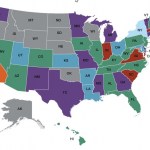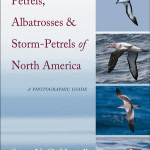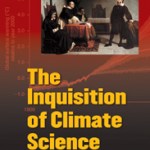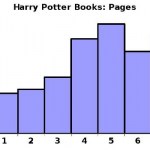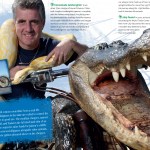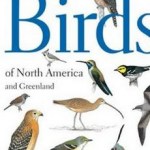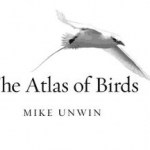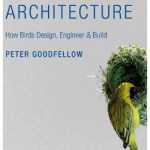Books
The vast majority of American public school students are not proficient in the level of science learning expected for their age group. The Thomas B. Fordham Institute has issued "The State of Science Standards 2012" as part of an effort to assess the causes of this dismal state of affairs. Here's a map summarizing their results:
State Science Standards Grades, 2012
Notice that some of the battleground states for the "Evolution-Creationism Controversy" have reasonable ratings. Notice also the vast regions of D and F states. In fact, in order to convey the meaning of it all, I've created…
Michael Mann, famous climate scientist, has released a book called The Hockey Stick and the Climate Wars: Dispatches from the Front Lines (also available as a Kindle edition). I've not read it yet but I thought you'd like to know about it.
Michael Mann is the guy who came up with the Hockey Stick graph and metaphor. Early reviews are positive:
In this meticulous and engaging brief on climate change research and the political backlash to legitimate scientific work, Penn State professor Mann narrates the fight against misinformation from the inside. (Publishers Weekly )
An important and…
Did you know that there is an entire group of birds called "Tube Noses" because they have tubes on their noses? Well, to be more exact, the term is "tubenoses" and the noses are beaks. The tubes are tubular nostril-like thingies that most (all?) birds have which are extra tube-like in the tubenoses. Thus the name.
Albatrosses, petrels, and storm-petrels, which includes shearwaters, make up the tubenoses, and the newly produced book Petrels, Albatrosses, and Storm-Petrels of North America: A Photographic Guide is about the North American species of this order, scientifically known as the…
Here are my best reads in English during 2011. I only read 38 books this year (blame the Internet), which is why the really good ones are fewer than usual.
Bonk. The curious coupling of sex and science. Mary Roach 2008. A charming look at the history of sex research.
The Culture of Fear. Why Americans are afraid of the wrong things. Barry Glassner 1999. If you don't already hate the US media, this book will kindle the flame.
Joy in the Morning. P.G. Wodehouse 1946. Extremely witty and extremely unrealistic.
History and the Gods. An essay on the idea of historical events as divine…
I'm spending this week in a semi-vegetative state: sleeping late, taking walks at noon with my wife & kids, eating chocolate, drinking tea, and reading. Here's my late-2011 selection of reading matter.
Svavelvinter. Erik Granström 2004. Swedish fantasy.
Proggiga barnböcker - därför blev vi som vi blev. Kalle Lind 2010. About the pinko hippie children's books of the 1970s.
20,000 Leagues Under the Sea. Jules Verne 1870.
Night Train to Rigel. Timothy Zahn 2005. Scifi. (Thanks Birger!)
Kinarapport 2011 Yearbook. About China.
Diktaren pÃ¥ tronen. Michael Nordberg 2011. About 13th…
Wildlife of Southern Africa , by Martin Withers and David Hosking, is new (August 2011) and good. If you are planning a trip to South Africa, Namibia, Botswana or anywhere nearby, or if you live there and like to go to the bush sometimes, consider it.
This is a pocket guide, it is small, has good photographs, is inexpensive, and accurate.
In my opinion, if you are travelling around Africa looking at wildlife, you will need a set of more specialized guides (which I've discussed at length elsewhere on this blog, see below), but this is a good extra to carry along or to have handy, depending…
The Fossil Chronicles: How Two Controversial Discoveries Changed Our View of Human Evolution and Born in Africa: The Quest for the Origins of Human Life are two very recent books on human evolution, both of which I recommend, depending on your interests.
The first is by Dean Falk, who has studied brain endocasts for the last 30 years. Falk chronicles her early work on endocasts, the relationship between that work and the much earlier work of Raymond Dart, in South Africa on the first Australopith fossil, and touches on the problems of being a woman with somewhat controversial findings to…
I'm enjoying James Lawrence Powell's book "The Inquisition of Climate Science" Powell's book specifically addresses the clilmate change denialist movement and the global warming deniers themselves, and does so severely. He documents and discusses who is paying for climate change denialism documents the lack of scientific credenntials of the denialists, and outlines and describes in detail events such as "climate gate."
The book is exceptionally well documented and could actually be used as a supplementary text in a class on science policy or science and society.
Author's bio from the…
I made the cut, and have an entry in Open Lab 2011, which means that I am one of 51 finalists. Which further means there are 50 articles over there you want to read. Which means I have just sent my readership away from here.
(Also on FtB)
Everyone knows that the number of pages per book in the famous series by J.K. Rowlings increased over time, but was this increase steady? Was it consistent? The answer seems to be no.
Looking at this graph, is is probably more accurate to say that the early books were a certain length, around 400 pages or less, and the later books (4 through 7) were longer, around 700 pages. This may seem like a trivial observation, and it probably is. But it is important to understand the basic pattern of page length over time in this series before we explore the more important and deeper meanings of…
The The Manga Guide to Relativity might come in especially handy these days, what with faster than light neutrinos, Republican candidates and other science-defying entities zooming around. And, it is one of those Japanese anime things, which makes it cool. This is a story set in Tagai Academy summer's school session, where the "plucky" Miss Uraga teaches the kids relativity.
When you have finished reading this book you will be able to calculate the effects of time dilation, explain the Twin Paradox, understand Einsteinium famous E=mc2 and get a job at CERN.
Hideo Nitta, is in the…
These are books that I've reviewed here, and would like to recommend that you seriously consider picking up if you are looking for a cool present for someone and you think they should read more science.
I'm including a couple of bird books in this list, but I also recently wrote up a summary of just bird books that you may want to check out.
These are in no particular order, and I'm not paying a lot of attention to publication dates. What matters is that I've I've put the book in this stack of books I've got here that I clean out every year about this time; Some are clearly older than…
New York Academy of Sciences Children's Science Book Award Winner Vicki Cobb has a new volume called "See for Yourself: More Than 100 Amazing Experiments for Science Fairs and Projects (Second Edition)"
Actually, it isn't entirely new. It's a second edition, but updated.
This is for 10 year olds and up, and it does in fact have 100 ways to make glue, fake old documents, extract DNA, do interesting anatomical experiments like finding your blind spot, produce your own ink, hypnotize your friends, make crystal flowers, etc. etc. all with common household ingredients.
It is paperback, richly…
Ripley's Believe It Or Not! Strikingly True is the kind of book you do not want to open up while your toddler is standing around looking for something to look at. Huxley may never be the same.
A pig with no back legs that walks upright on its front legs? People with very large numbers of toes? Squid?
And, most shockingly, ectoplasm. You've gotta love the ectoplasm.
The world is a strange place, and everybody has a camera, so I think there will be no shortage of new volumes in this series of books about the bizarre. This particular issue seems to be more icky and shocking than usual, but…
If you read only one book this holiday season, make it all of the following twenty or so!
But seriously ... I'd like to do something today that I've been meaning to do, quite literally, for years. I want to run down a selection of readings that would provide any inquisitive person with a solid grounding in Behavioral Biological theory. At the very outset you need to know that this is not about Evolutionary Psychology. Evolutionary Psychology is something different. I'll explain some other time what the differences are. For now, we are only speaking of fairly traditional Darwinian…
Why would you want a field guide to all of the carninvores? They live everywhere, so there is no reason to carry around a field identification guide with ALL of them unless you were going everywhere in the whole world on one trip!
Yet, there is such a field guide, Carnivores of the World (Princeton Field Guides), and the truth is, this is ONE OF THE COOLEST BOOKS I'VE EVER SEEN! All the carnivores (almost) in one book. Interestingly, it turns out to be possible. There are fewer than three hundred species of terrestrial carnivore in the whole world, and that is fittable in a single book…
Face it. Half the time ... most of the time, really ... you use your Peterson (or some other favorite "field guide") as a checklist. You see a bird and you pretty much know in your head what it is, but you need to look it up to see what the three or four similar ducks or woodpeckers or whatever are in your area in order to be sure that it is a Common Merganser or a Red Headed Woodpecker or whatever. All you need is a basic picture (drawing preferred for this sort of thing) the names of the birds and basic range maps.
That is the role played by the Princeton Illustrated Checklists; These…
How are birds related to dinosaurs, crocodiles, and pterosaurs? Where do birds live, and not live? How many bird species are there, and how many actual birds, and how does this vary across the glob? What about endemics?; Where ate the most local species found? Mike Unwin's The Atlas of Birds: Diversity, Behavior, and Conservation covers this and more in a richly illustrated detailed global survey of Aves.
This new and very impressive, and highly accessible volume covers bird biogeography with an overview of counts and diversity followed by a continent-by-continent review, to give you an idea…
Birds don't live in nests. They make nests for specific purposes, use them for that purpose, then abandon them. Or, sometimes they don't abandon them, but rather add on and use them again and again, but in between they don't live in or on them. Well, sometimes they hang out on them a lot. And not all nests are for putting their eggs in. In fact, sometimes a nest is more of a symbol of quality and overall bird sexiness than it is a place to keep the chicks. As it were. Oh, and sometimes they live in the nests, now that I think about it ... It's complicated.
But there is a book that…
Suppose you are an intelligent, thoughtful person with a thirst for information, a desire to be challenged, and a tendency to not accept received knowledge at face value. You are embedded in a traditional Christian culture where most of your family, your child's teachers and friends and those friends' families, the people where you and your spouse work and most people in your social circles assume that Evolution is "only a theory" and should be taught, if at all, along side alternative theories such as that the earth is 6,000 years old and was created in seven days. But you don't want that…
